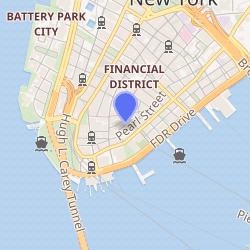1 Hanover Square
1 Hanover Square, formerly known as the India House, is on the southern edge of Hanover Square in Lower Manhattan, New York City. Built in 1851, it was the site of the nation's first commodity futures exchange, the New York Cotton Exchange. In recognition of that function, it was designated a New York City Landmark in 1965 and a National Historic Landmark in 1977.
New York Cotton Exchange | |
1 Hanover Square, also known as India House | |

| |
| Location | Hanover Square, Manhattan |
|---|---|
| Coordinates | 40°42′16″N 74°00′37″W |
| Area | less than one acre |
| Built | 1851-1853 |
| Architect | Richard F. Carman |
| Architectural style | Renaissance |
| NRHP reference No. | 72001586 |
| NYCL No. | 0042 |
| Significant dates | |
| Added to NRHP | January 7, 1972[1] |
| Designated NHL | December 22, 1977[2] |
| Designated NYCL | December 21, 1965 |
Description and history
1 Hanover Square is located on the west side of the eponymous square in the Financial District of Lower Manhattan. It is a three-story masonry structure, built out of brownstone in the Italian Renaissance style. The main facade is eight bays wide, with the main entrance occupying two bays at the center. Windows on the ground floor are tall, and set in openings flanked by paneled pilasters and topped by pedimented segmental arches. Second-floor windows are smaller, set beneath gabled pediments, and third floor windows are smaller still, with simpler surrounds. The building is crowned by a modillioned cornice.[3]
The structure was constructed as a commercial investment by the builder, developer and merchant Richard F. Carman in 1851-53. It was the headquarters of the Hanover Bank. In 1870, the New York Cotton Exchange was founded here, the second such exchange in the world and the first exchange in the United States to deal in commodity futures (contracts specifying the delivery at a future date of a particular commodity).[3]
The building served as the headquarters of W.R. Grace and Company from 1885 until 1913, when it was purchased by the India House, a private club for gentlemen involved in foreign commerce.[3] It was declared a National Historic Landmark in 1977.[2][3] It currently houses restaurants. It was also used in the 2001 film Kate and Leopold as Leopold's family home.[4]
See also
References
- "National Register Information System". National Register of Historic Places. National Park Service. January 23, 2007.
- "New York Cotton Exchange". National Historic Landmark summary listing. National Park Service. 2007-09-11.
- George R. Adams (December 1976). National Register of Historic Places Inventory-Nomination: New York Cotton Exchange (pdf). National Park Service. and Accompanying photo, exterior, from 1964. (1.11 MB)
- "Kate and Leopold Film Locations". onthesetofnewyork.com. On the set of New York. Retrieved 2013-07-01.
External links
| Wikimedia Commons has media related to 1 Hanover Square. |

